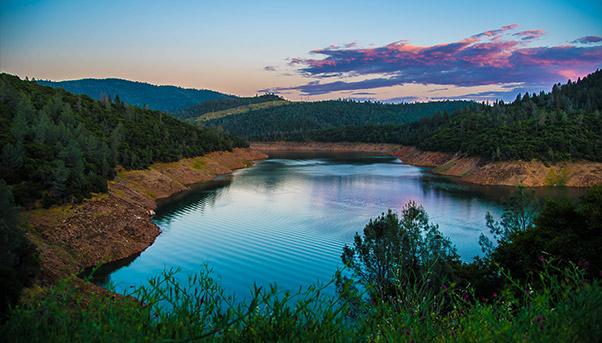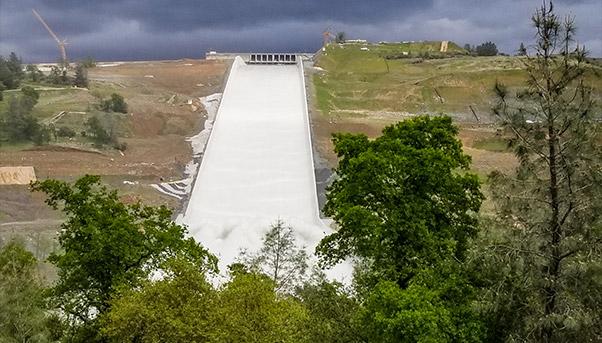
It could have been one of the greatest disasters in American history. An unprecedented flood put thousands of lives at risk, and created an emergency that led to the evacuation of nearly 200,000 inhabitants from the city of Oroville.
But 2017 Oroville Dam crisis is now just a memory. Renovation work on the highest dam in the United States, and one of the highest in the world, is almost finished and the dam now working again. The emergency repairs that were carried out two years ago after the failure of the dam’s excess water drain-off, or spillway, have won recognition as the largest and fastest infrastructure project in the history of California.
Oroville: a race against time
The reopening of the first part of the damaged spillway on the 770-foot high (234-metre) Oroville dam was in April. It was a key step towards restoring full functionality, and technicians and workers continue fixing it today.
In order to make the dam safe, the spillway, where the dam’s water is let out to avoid flooding, needed to be fixed. The reconstruction work will create a reinforced spillway that can withstand a flow of 270,000 cubic feet (7,645 cubic metres) of water per second, well beyond the maximum levels reached even in the most critical moments. To do this, workers poured enough cement to fill 370 Olympic pools, and 12.4 million pounds (5.6 million kilos) of steel were used to reinforce the cement.
The work, which cost $1.1 billion dollars, was commissioned by the Department of Water Resources of the State of California. Due to its complexity and speed, ENR, one of the most prestigious magazines of the sector, named in California’s best water infrastructure project of 2019.
«The Oroville Spillways Emergency Recovery Project is an incredible example of what the infrastructure industry and its agencies can accomplish in a very short time if we all have the same goal and the urgency to accomplish it», said project director Jeff Petersen of the Oroville Spillways Emergency Recovery Project.
Petersen said the teamwork was responsible for the project’s rapid completion time.
«For us, the realization of that accomplishment was felt back in April when we were able to watch the first water spill down the main spillway», Petersen continued. «More than 1,000 people from Kiewit, our subcontractors, the Department of Water Resources, its designers, stakeholders and key regulatory agencies put their lives on hold for 18 months to rebuild this project—and I don’t think we’ve ever been so excited to see water flow down a spillway».
However, work has continued in recent months and continues to this day. The objective now is to fine-tune the dam’s huge reservoir response to the operation of the spillway in order to receive certifications from bodies the California Division of the Safety of Dams and the Federal Energy Regulatory Commission.

How the crisis happened
The Oroville dam, inaugurated in 1968, had been built with a main spillway and a second spillway that would have been used only in an emergency. That emergency occurred for the first time almost fifty years later, in February 2017, the wettest winter in the last 100 years. A series of heavy rains lashed California and the dam, increasing its reservoir level. Water was sent pouring out over the main spillway, which could not take the pressure and developed a hole the size of a football field. To avoid the worst, the water was diverted to the emergency spillway, which cascaded down a hillside, quickly eroding it and placing the local population at risk.
The authorities were forced to order the evacuation of Oroville, the city 75 miles north of Sacramento, in a mass operation that involved almost 200,000 people.
Oroville, an asset for the nation
The Oroville Dam is one of the great American dams, and California’s second-largest reservoir, where 4.3 trillion liters (1.1 trillion gallons) of water are collected.
The California Department of Water Resources financed its construction, which began in 1961 and ended in 1968, and also built the largest underground hydroelectric plant in the USA, the Edward Hyatt Pump-Generating Plant. The purpose of the work was threefold: to avoid flooding in the Sacramento valley, to manage the water supply of the area (in particular the San Joaquin Valley and Southern California), and to produce clean energy for the state of California.
California dams at risk
The crisis that hit the Oroville dam was a wake-up call for the whole of California. The state has 1,585 dams, 17 of which are in critical condition, according to the National Inventory of Dams written by the United States Army Corps of Engineers.
Most of the Californian dams were built between the 1960s and 1970s, and now require urgent maintenance work. The most urgently in need of care are the Anderson Dam and the Calaveras Dam, near San Jose. At the Lake Isabella Dam built in 1950, which is vulnerable to earthquakes, Californian authorities have lowered the water level limit.
Dams are a problem not only in California, but throughout the United States. According to the American Association of Civil Engineers (ASCE), American dams have a serious aging problem. To fix the ones that place lives at risk today would take $45 billion, becoming $71 billion if we consider maintenance needed on all the dams, it said in a 2017 report.
A widespread emergency that, as events at Oroville demonstrate, must be addressed before it is too late.

